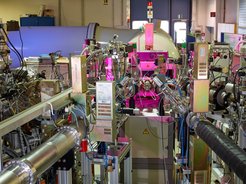Tandem Accelerator
The division operates an ion beam analysis lab with a 3 Megavolt tandem accelerator.
The tandem accelerator creates ion beams with energies of a few MeV and is used for the quantitative analysis of surfaces, as well as to create radiation damage in materials and to implant impurity atoms.
The program SIMNRA is being developed for simulating and analyzing MeV ion beam analysis spectra. SIMNRA is used in more than 200 laboratories for ion beam analysis and is the leading program of its kind worldwide.

The accelerator is a 3 MV tandem accelerator from High Voltage Engineering. It was installed in 1999 and has two ion sources:
- a Cs sputter source for generating protons, D, Li, C, O, Si, W, ... ions
- an RF ion source to create 3He and 4He ions.
The following experimental and analysis stations are available:
RKS is a standard analysis station for small samples of different geometry. Analysis options: RBS at 165° and 105°; NRA with wide area proton counters; ERD for the detection of light species such as H, D and He.
The SAK device is equipped with a glove box for the analysis of poisonous materials, especially beryllium. Analysis options: RBS at 165° and 105°; NRA with a wide area proton counter; PIXE.
The BOMBARDINO experiment has a replaceable top flange which allows flexible experimental set-ups and is equipped with two ion sources. It facilitates the analysis of large samples (up to 20x10x10 cm3, weight to 5 kg) with RBS, NRA and PIXE, or the simultaneous irradiation of small size samples with two different types of ions in the energy range from 500 eV to a few keV.
At the TOF-IBA bemline large-area irradiation of samples for specific creation of radiation damage can be performed.

Ion beam analysis methods
Foil-ERD
Elastic Recoil Detection enables the detection of light elements by measuring the energy of recoiling ions in forward direction. The heavier projectiles are stopped in a thin absorber foil. ERD allows depth profiling of individual light elements.
NRA
Nuclear Reaction Analysis allows the specific detection of individual isotopes of an element. For example, the heavier hydrogen isotope deuterium can be determined through the nuclear reaction
3He + D → 4He + p
by detecting the high-energy proton. NRA is often almost background-free, but often does not provide depth profile information.
PIXE
Particle Induced X-ray Emission allows the detection of individual elements by measuring their characteristic X-ray line emission during bombardment with energetic ions. PIXE is best suited for the detection of medium heavy elements. The method is very sensitive and allows the detection of very small amounts, but does not provide any depth information.
RBS
Rutherford Back Scattering allows the detection of heavier elements by measuring the energy of light backscattered projectile ions. The energy allows the determination of the mass of the struck atom and the depth, where the atom is located. RBS therefore allows the determination of depth profiles of individual elements.

